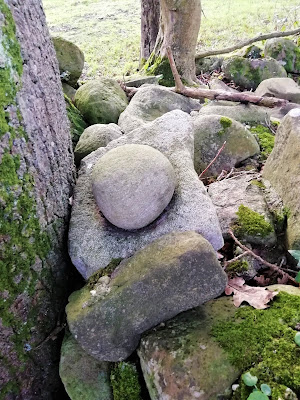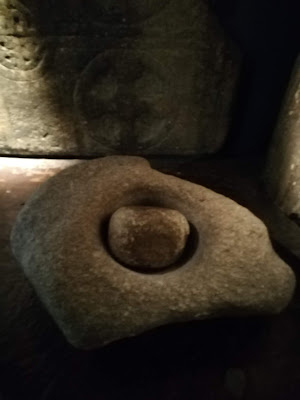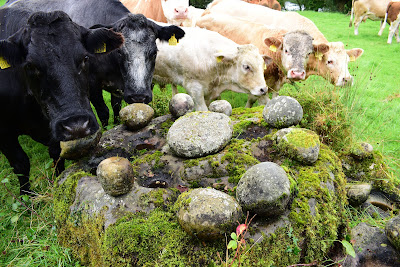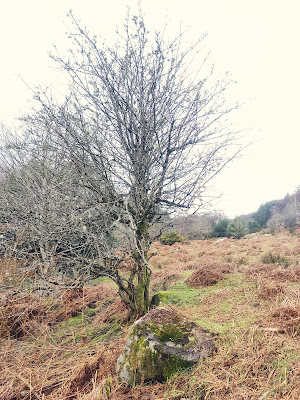Found throughout Ireland and quite numerous there are many fascinating "Bullaun Stones."
Roscam, Galway - Associated with Saint Patrick.
Bullaun Stones are stones which have hollows or depressions carved into them, either a single hollow or multiple hollows or depressions. Many are shaped like a "bowl."
Clonmore, Carlow - Large multiple Bullaun.
They range very often in size from as little as 20 Centimetres across to as large as several metres measured along their upper surface. The difference in size, shape, and number of depressions make Bullaun Stones quite unique and difficult to categorize. They vary in shape and style considerable.
Saint Molua's Stone - Kyle, Laois.
The origins of Ireland's Bullaun Stones are lost in the mist of time however similar Stones are also found in Britain as well as in continental Europe and throughout the world.
Probable Bullaun - Church of Ireland, Aghade, Carlow.
Today the majority of Irish Bullaun Stones are found close to ancient sites of ecclesiastical importance such as early Christian monasteries and Churches and alongside Holy Wells and sites of pilgrimage.
Bullauns - Saint Peacauns, Toureen, Tipperary.
It's very unlikely that the present religious associations and settings are the original source of Ireland's Bullaun Stones.
Bullaun and Holy well - Cumber/Forelacka, Offaly.
At a guess it would seem likely that some Bullaun Stones must have originated as some form of prehistoric grinding stones much like a Mortar and Pestle or a Saddle querns.
Bulluans - Killamery, Kilkenny. Is the lower stone a Bullaun or a Holed Stone ?
To my knowledge the only way to date stone usage without written records is if it
(the stone) has recently been excavated and can be tested for how long ago it had previously been exposed to sunlight.
It would seem that dating pre-existing Bullauns is a non runner.
Glendalough, Wicklow - One Bullaun has been repurposed into the Altar.
What can be said with certainty is that they are a multi period artifact in the Irish landscape and an intriguing and beguiling one at that.
It is entirely possible that some of them may have been Bronze age or even Neolithic grinding tools.
Small Bullaun - Castletown Cemetery, Drumroe, Tipperary.
I presume a lack of finds near neolithic sites may make this seem unlikely however given the portable nature of most Bullaun Stones perhaps they were moved and repurposed over the millennia, who knows?
Saint Berriherts - Tipperary. Bullauns or Swearing Stones ?
The Bullaun Stones found in Ireland today seem to have very ritualistic purposes and most are associated with local myths, legends, and traditions.
Many are still an integral part of local worship and veneration at sites of pilgrimage throughout the Country.
Killone Bullaun on Kilmurray Hill, Laois.
Along with the obvious depressions which are the defining feature of Bullaun Stones several have further interesting marks, grooves, or hollows which are often ascribed to the marks made from where venerated Saints knelt when praying, their hand prints when worshiping or the marks of Horses or Cows hooves etc. etc.
Lemanaghan Offaly - Associated with Saint Manchan. Bulluan at Well and on ancient Togher.
It's mooted that the Bullauns in the lower photo were left behind by the Saints Cow when it was stolen by a thief and he was then able to track the Cow down by following its hoof marks.
The Bullauns, some of which may have originated as a type of early milling stone are now often used for ritual purposes and are often believed to have magical or healing properties. They are sometimes associated as sources of cures for different ailments.
Bullaun on ground - Gallen Priory, Ferbane, Offaly
Some were also repurposed as "Cursing Stones" or "Swearing Stones."
There are several traditions of using Bullauns to cast a spell or curse and also of using them to swear an oath or obligation.
Kilmurray Hill, Laois. Another picture of the Killone Bullaun.
It doesn't take much of a stretch of the imagination to visualise a distant relative centuries ago after a "night on the tear" and some misfortune pleading or entreating at a Bullaun stone or in other instances asking for a favour, healing grace, or placing a curse ..........
"I swear, I swear. I'll never touch a drop again if......."
A Large number of Bullaun Stones are located at devotional sites and places where votive offerings are left and prayers offered to Saints associated with the locality.
Glendalough in Wicklow contains an unusually large number of Bullaun stones with over 40 recorded in the area, attesting to their religious significance in the locality.
Some of the many uses and purposes to which Bullaun Stones may originally have served have been mooted as ; grinding stones for grains or nuts, crushing herbs, metal ores and colour pigments, and making medicines.
Each of these suggested ancient uses seems quite plausible in its own right and we will probably never know for sure. In fact some may have origins or uses for which we could never even begin to hazard a guess.
Double Bullaun at Saint Peacauns in Tipperary.
Occasionally it is difficult to be certain a stone is in fact a Bullaun Stone as it may be a repackaged Font or Stoup or just a weathered conglomerate rock but most Bullauns are fairly easily identified.
Small single Bullaun at Saint Fintans Well, Cromogue, Laois.
Ireland's Bullaun Stones are a striking and evocative archaeological record of times past and present throughout the Country.
Myths, legends, local folklore, and ecclesiastical associations have served to keep most of them "in situ" and intact so that they remain in place for future generations to enjoy.
Killinagh Cursing Stone - A large multiple Bullaun and two other Bullaun Stones in a group, Cavan.
They also provide a valuable link to the past and serve as a visible reminder of our sometimes forgotten history and heritage.
As technology advances further the old "oral tradition" fades and the meaning and purpose of relics can be lost or forgotten, particularly concerning obscure local traditions and folklore.
An impressive and large Bulluan Stone, the Nine Hole Stone in Offaly.
Wherever you live you will probably find that you are not too far from a Bullaun Stone. Perhaps you were unaware of its existence and passed it by without even knowing it was there.
The stone probably has a tale to tell if you dig a little deeper......
Saint Brigids Stone. A large and unusual upright positioned Bullaun Stone at Ballybuggy in Laois.
Bullaun Stone with depression and channel at Morett in County Laois beside Saint Brigids Well.
A single Bullaun Stone outside Ballynakill Church in Galway, perhaps once used in rituals as a font.
Another large single Bullaun Stone at Kilcorban medieval Church ruins in Galway, a lovely quiet area close to Pallas Castle....
This multiple "earthfast" Bullaun at Aghowle in Wicklow was referred to by a local as the "Baking Stone". It looks like a frog with a crooked smile.
Below are several small Bullaun Stones found in the general area of Kilkieran and placed beside each other at the ancient ecclesiastical site in Kilkenny.
Killadeas in Fermanagh plays host to this unusual upright "possible" Bullaun Stone which also serves as a Cross inscribed stone. The ringed Cross is on one side and the multiple Bullauns, possible prehistoric cup marks, are on the other.
Saint Patricks Bullaun Stone and Raggedy Bush, Bamford, Kilkenny. Easy to miss.
The "Wart Stone" in Offaly is a single Bullaun on an elevated and
elongated rock platform which reputedly served as an altar for Mass during the period of the
Penal laws in Ireland.
A lone Bullaun Stone at Killina, Rahan, Offaly.
A beautiful Bullaun which has been carved into a small rocky outcrop beside an abandoned Board of First Fruit Church at Kilruane in Tipperary.
At the large ecclesiastical settlement of Clonmacnoise in Offaly there are just two Bullaun Stones recorded. In comparison there are over 40 recorded at Glendalough in Wicklow.
It's possible that at one time there were many more Bullaun Stones at Clonmacnoise and they have been long since lost or forgotten about.
The one pictured above and below is known as "Glun Tinnis Cinn" or "the knee-stone of the head-ache".
Being one of only two at Clonmacnoise it is very unusual. The stone is listed as lying north of the Pilgrims Road (behind the hedge) "9 chains from the Graveyard".
An Irish Chain is an old unit of measurement which was 100 Links or 4 Rods in length.
This was about 84 feet in length and the measurement was originally thought to refer to a Surveyors chain.
This Bullaun at Clonmacnoise was partially buried and I wasn't properly equipped to uncover the full stone.
What is in no doubt is that unless it is protected properly it is likely to be destroyed in short order by agricultural machinery or passing vehicles.
It has an unusually large depression and reputedly other depressions made from kneeling. I didn't get to uncover these on the day in question. My bad photographs don't fully convey its size.
At the wonderful Temple Cronan Church in rural Clare are two beautiful Gable shrines while inside the Church is a single elongated stone slab with a single depression in it.
There is no Bullaun listed here however the single depression is unmistakable so I'm taking it to be a Bullaun stone of one type or another. I'm not an archaeologist so authoritative verification is outstanding however I believe it is a Bullaun.
The angle of the light made photographing the stone difficult and the pictures are a little washed out. The stone is rectangular in shape and outline. The depression is shallow and could easily be missed in the wrong light.
Near Knickeen in Wicklow by a marshy area near a stream are two interesting Bullaun Stones. One is known as Saint Laurence O'Toole's Hand Print.
One Bullaun is cracked and has two depressions carved into it while the other is a multiple Bullaun Stone partly submerged with at least six and perhaps more Bullauns carved into it.
Three single Bullaun Stones located at the wonderful ruins of Clonygoose Church in Carlow.
A single Bullaun Stone by Saint Fortchern's Holy Well in Carlow. The Well and Bullaun are close to the early 10th Century "White" Church just across the road.
A single Bullaun which may once have served as a base for a Cross at Finglas Graveyard, Loughan, Offaly.
Nearby Dunkerrin has a memorial for Kate Shell(e)y who is remembered in Iowa for averting a train crash and had a bridge named in her honour.
She was the first woman in the USA to have a bridge named after her and a Locomotive was named the Kate Shelley 400.
A beautiful earth-fast Bullaun Stone at Cemetery Hill in Wicklow. It is situated in what now seems a peculiar position but perhaps it's position was much more prominent previously and the land and situation surrounding it has changed.
A single Bullaun at Glenbower near Killeagh in Cork. It is located beside what appears to be the base of a Cross by the side of a woodland trail.
--------------------------------------------------------------------
-------------------------------------------------------------------------------------------
The information below is directly copied from my page on Glendalough's Bullaun Stones so the page is just a copy of the info and pasted below :
I have listed the Bullaun Stones at Glendalough with a snippet of information on each and its record number as described on the Sites and Monuments Records (SMR).
I hope you enjoy the photographs and I have piqued your interest.
Keep the wheels turning.
----------------------------------------------------
WI023-066
This is a moderately sized Bullaun Stone with a single basin which looked Hemispherical to me and is described as located outside what was once the "Caretakers House."
-------------------------------------------------------
WI023-006003
This is an irregularly shaped Bullaun which is located in the middle of the Glendasan river perched on its side. The stone appears trapezoidal in shape and in certain light shows a beautiful golden brown hue.
Located in the flowing river water it certainly makes for one of the more unusual settings or placements of Bullaun Stone. How it got here we will never know.
There is another Bullaun further upstream also in the middle of the river, WI023-006004. It is only visible at low water levels and is about 15 metres away from this Stone. I have no photograph of it.
------------------------------------------------------
WI023-006001
This is another Bullaun Stone with a single basin. It is on the edge of the riverbank almost directly opposite the previous Stone. Irregularly shaped with a well defined basin it is easy to locate.


--------------------------------------------------------
I have no information on the following two Bullaun Stones. They are lying near what I think is a small Christian Retreat centre.
It's possible they have been relocated here from elsewhere in the immediate area. It's unlikely that this is their original location. They are set beside a piece of early machinery and set in a rock border. Both have a single basin.




-----------------------------------------------------
WI023-004002
This is an interesting Bullaun Stone. Totally covered in vegetation but once cleared it first shows as flat and almost table shaped with a single basin.
The stone on closer inspection appeared to be divided by a slight and shallow linear carved depression which divided it in two.
The photographs below show it with and without vegetative cover. Initially it had looked almost square shaped until removal of the overgrowth exposed the full extent of the Stone.




----------------------------------------------------
WI023-005002 / WI023-005 / WI023-005001 / WI023-005003
There is a group of four Bullaun Stones near the previous Stone. They are referred to as the "Seven Fonts."
The group consists of two medium sized Bullaun Stones with single basins, a large and very irregular shaped Bullaun Stone with a single basin and an extremely large and unusually shaped Bullaun Stone with four basins.
This accounts for the name of the group as the "Seven Fonts."
The largest Bullaun Stone in the group has four basins but three of the basins are carved into their own little enclave in a flat rectangular carved portion of the Stone and separated from the final fourth basin.
Covered in vegetative growth the smaller of the Bullaun Stones can be difficult to locate. I've included photographs at various states of overgrowth and used red circles to indicate some of the Stones.
----------------------------------------------------
In the same field are three further Bullaun Stones.
WI023-005007
This incorrectly refers to a Bullaun Stone with a single basin. This Bullaun Stone is in fact a record from Paddy Healy/1972 now marked as redundant which refers to a Bullaun Stone with two basins. WI023-005005.
The initial record by Healy was correct and the Stone was possibly partially covered in mud when it was later inspected and re-recorded as a Bullaun with a single basin.
This Bullaun Stone with two basins appears to have a shallow line carved along the Stone to one of the Bullauns.
-------------------------------------------------
WI023
This is a moderately large Bullaun Stone with a single basin. The top is wide in relation to its single basin and it is very distinct and quite flat.
Located directly beside a small tree, a type of thorn.
----------------------------------------------------
WI023-005004
Another Bullaun Stone in the same field with a single basin. It is located east or east-southeast in the field near a boundary fence and close to another small tree.
The Stone seems to have settled at a slight angle. There is another Bullaun Stone mentioned in this field but is is unlocated and unmarked.
It is possible that there are many more Bullaun Stones hidden beneath the soil surface here.
------------------------------------------------
In a field across the road from the field of the "Seven Fonts" there are a further three Bullaun Stones one of which has two basins directly opposed to each other on the two corners of the Stone. It is quite striking and somewhat unusual.
WI023-042
This Bullaun Stone has two basins. The top is the only part of the Stone that is exposed and it is very flat in shape.
The arrangement of the basins opposing each other is very visually striking. What purpose this serves we can only guess at. The first photograph shows the Stone in an overgrown state and difficult to interpret until cleared.
Located beside the previous Bullaun Stone with two basins are the two further Bullaun Stones each with single basins.
------------------------------------------------------------------
WI023-043 / WI023-044
These two single Bullaun Stones lie close to the previous Stone. The furthest is roughly one metre away.
From the records I cannot differentiate between 043 and 044.
One Stone appears to be a "typical" medium sized Bullaun Stone shape with a distinct basin while the other is completely irregular and elongated with a very atypical shallow basin.
All three Bullaun Stones are located very close to each other and almost with touching distance.
----------------------------------------------------------------------
WI023-008010
This Bullaun Stone has been set on its side into the North wall of the Cathedral at Glendalough inside the building and near the north east corner.
It is a bright and cheerful Bullaun Stone with a single basin in an unusual setting.
-------------------------------------------------------------------------
WI023-009011
This small Bullaun Stone is set into the ground near Saint Kevin's Church which is also known as Saint Kevin's Kitchen.
It is set in the ground under luscious green grass and has some small little pebbles in it alongside the clear rainwater it collects. It is a beautiful little Stone.
---------------------------------------------------------------
WI023-002
An unusual setting here. This Bullaun Stone is set into a Wall at a Cottage entrance in Glendalough.
The basin is very shallow and the stone is set partially into the ground making it difficult to spot.
WI023-002001 is another Stone at this location which is supposed to be located inside the gateway but the property here is private.
---------------------------------------------------------------------
WI023-011
The Deer Stone. This is probably the best known and certainly the most often seen Bullaun Stone at Glendalough. It lies near a bridge across the Glenealo river.
It is a flat topped Bullaun Stone with a single basin surrounded by other granite stones of various shapes and sizes.
Saint Kevin is reputed to have been very close to nature, wildlife and animals. There are various legends associated with the Deer Stone.
Some mention the Saint raising an orphan and needing milk to feed the child. A deer would leave milk for him in the hollow of the Deer Stone.
----------------------------------------------------------------------
WI023-003002
This Bullaun Stone is located in the ruins of Saint Mary's Church and has been inserted into the Altar at there.
It is unusual among the Bullaun Stones at Glendalough where most of the Bullaun Stones are of granite rock while this Bullaun Stone is Schist.
--------------------------------------------------------------------
WI023-009008 / WI023-009061
Inside Glendalough Visitor Centre are listed the two Bullaun Stones numbered above.
One is described as a single basin and the other is described as having two basins.
The photograph below is of a Stone in the Visitor Centre I took quite some time ago however I didn't take note of its significance at the time. I assume it is Bullaun Stone WI023-009008 however I can't be sure until I get back some time to double check.
--------------------------------------------------------------------------------
-------------------------------------
Large upright single Bullaun Stone at Killucan, Westmeath.
One of just two Bullaun Stones recorded at Clonmacnoise in Offaly. This delightful example is sunken to ground level.
A Bullaun Stone beside an original High Cross base at Terryglass in County Tipperary.
Bullaun Stone at Cahir Abbey Tipperary.










































































































































.jpg)
.jpg)
.jpg)
.jpg)
.jpg)
.jpg)